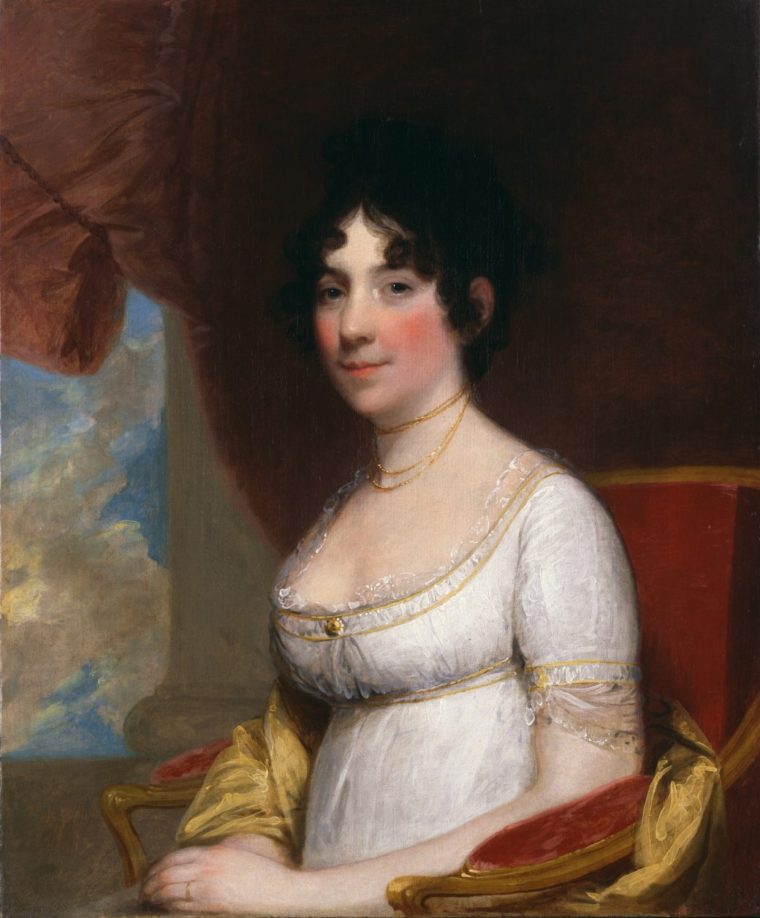Dolley Madison (1768-1847) The American “First Lady”
Introduction
Dolley Madison (1768–1849), one of the most renowned American first ladies, was President James Madison’s wife. She was born in North Carolina and spent her life’s early years in Virginia in a very simple environment. In 1790, she married John Todd but he died only after three years due to the yellow fever epidemic. In 1794, Dolley married Madison and became the fourth first lady of the United States of America. In the subsequent years, Dolley proved herself as a charming, tactful and graceful official White House hostess for both President Jefferson and President Madison. It won’t be incorrect to state that her guts, courageousness and the manner with which she conducted herself shaped the role of first lady in the Unites States of America forever.
Madison Decorate White House
When Madison took the office in 1809, Dolley took up her role as the first lady very seriously and concentrated on the decoration of the White House that was almost empty at that time. Due to her efforts, the fine art, libraries, an orphanage, and the Washington Monument building were promoted. Due to her sincere hard work, she soon gained fame and popularity all over the United States of America. A lot of people believe that the White House walls witnessed Dolley as the first person who dished up ice cream.
Dolley Epic Actions in 1812 War
However, Dolley is rather acknowledged for her gallant and epic actions in the 1812 war. One of her other greatest achievement was the promotion of both city and manor as national symbols of identity. Without a doubt, it was that period in which the people in America had started to identify with the city and the White House. Dolley’s hard work in this field became even more critical after the invasion of the capital and the White House in 1814. When Washington was attacked by the British armed forces in 1814, Dolley was present at the White House while President Madison had gone outside the city with his defense force, Before leaving the White House, Dolley was successful in gathering the government papers that were of vital importance. She also persisted to take a famous George Washington portrait along with all the other important things. The painting was then removed and was loaded in a wagon by her servants along with all the important papers she had already saved. Due to her witty nature and daunting attitude, everyone in the White House managed to escape before it was burnt down by the British.
Promotion of Bipartisanship
Dolley Madison was not only an enigmatic first lady but she also worked excellently for the promotion of bipartisanship and brought together various political leaders. Not only this, she managed to keep the country united in various ways and thus set a standard for the first ladies after her. She was well aware of her alluring personality and used it to socialize with leaders of political parties. By doing so, she was successful in bringing the enemies closer together as friends thus encouraging courteousness and a universal apparition of the developing nation.
As already mentioned, Dolley is widely admired as the decorator of the White House. If truth be told, she was in fact the restructurer of White House. In the previous times when she did not reside in White House, the city had not a single place where government officials or their families and the local community could get together. Before her, America demonstrated violent behavior politically and people used to fight even on Congress’ floors. However, Dolley’s drawing room proved to be that one place where both government officers and their families could meet. The vigilant eyes of Dolley made the influential people to learn mutually and work in unison by adopting bipartisan ways. As the political system in America did not have an official two-party system, the anticipated aim of Dolley’ to bring everyone into the room and making them learn to behave and intermingle as human beings was an imperative effort to make.
An Intelligent Woman
Dolley was an intelligent woman and availed every drawing room opportunity to use the social circles for doing realistic and politicking for James Madison. Her participation in every crucial matter of diplomatic relations proved really beneficial for as her frequent interventions broke the ice between her husband and a number of politicians and government officials. She was a witty lady who knew how to use words, food and her gracious nature to lessen the intensely hot debates and conversations. Dolley turned out to be one of the most important benefactors in the history of America by “giving many prominent men, such as Nicholas Trist, the diplomat, their start in government service, while creating ties between her family and other powerful political clans”. She had a really large network that crossed regions and parties.
End of Madison’s Second Term
Until the end of Madison’s second term in the office in 1817, James and Dolley Madison lived in Washington. They then chose Virginia as their home and lived there till 1836 (the year of Jame’s death). In 1837, Dolley returned to Washington and picked up where she left off as a well-liked hostess in the White House for President Jefferson. Her responsibilities included the entertainment and amusement of friends and government representatives.
Appealing Figure
Dolley was also successful in inventing a role for all the subsequent First Ladies. She modeled herself as the “appealing figure” for her husband’s government. The bureaucracy was absent and established constitution in the federal government was the sign that the people in America put great emphasis on leaders for assertion and encouragement. Following the Revolution, the Americans looked up to the personality and example of George Washington as their ultimate hero. Thus, this place was taken up by Dolley Madison during the controversial early state. Dolley was a celever lady in a positive manner and used personality to dominate people with her appearance and conduct. She was able to use her beautiful costumes, bountiful entertainments and sense of simplicity for transmitting messages of authority, firmness and encouragement to the people of the Western World. However, her good heart made people like and admire her as compared to her outer appearance. She had a special ability of making people feel exceptionally unique. Her sharp memory allowed her to never forget a name, face or an individual’s background. In short, such admirable qualities of compassion, tenderness and chivalrous concern are enough to reveal why she is still unforgettable, famous and well-recognized.
Conclusion
Dolley was indeed the first American “First Lady” who led the social scene in the American capital. She introduced an interestingly unique fashion of her own and played politics in the indirect way that wasn’t done before. She was a favorite among both domestic and international officials due to her admirable personality that knew how to win hearts. Her compassionate soul left her physical body in 1849 at the age of 81. Her funeral was attended by thousands and thousands of people who admired her and thus revealed her dignified status. Dolley had an exceptional ability of bringing people together. Therefore, it won’t be incorrect to say that she did the same at even at her final event on the Earth.
References
Allgor, C. “The Politics of Love.” Humanities 31 1 (2010): 14-53.
“Madison, Dolley from The Columbia Encyclopedia, 6th ed..” Questia. http://www.questia.com/read/1E1-MadisonD/madison-dolley (accessed September 9, 2013).
McDevitt, T. “Dolley Madison: The Problem of National Unity.” Library Journal 137 17, no. 82 (2012).
[1] The Columbia Encyclopedia, 6th ed. (Columbia University Press, 2013), s.v. “Madison, Dolley,” http://www.questia.com/read/1E1-MadisonD.
[2] T McDevitt, “Dolley Madison: The Problem of National Unity,” Library Journal 137, 17, no. 82 (2012).
[3] T McDevitt, “Dolley Madison: The Problem of National Unity,” Library Journal 137, 17, no. 82 (2012).
[4] C Allgor, “The Politics of Love,” Humanities 31, 1 (2010): 14-53.
[5] C Allgor, “The Politics of Love,” Humanities 31, 1 (2010): 14-53.

